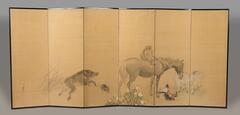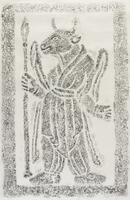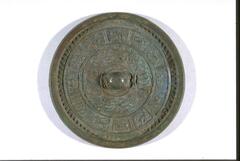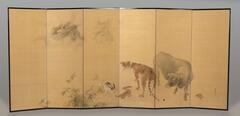15 UMMA Objects
15 UMMA Objects
Korean (Korean (culture or style))
Twelve Zodiac Animals: Sheep
1945 – 1980
Transfer from the Department of the History of Art, Slide and Photograph Collection, gift of Mrs. Pilsoon L. Chun
2021/1.128.8

Yoshikawa Kôkei
Animals of the Zodiac (Two of pair)
1924
Museum purchase made possible by the Margaret Watson Parker Art Collection Fund
2003/1.383.2

Korean (Korean (culture or style))
Twelve Zodiac Animals: Snake
1945 – 1980
Transfer from the Department of the History of Art, Slide and Photograph Collection, gift of Mrs. Pilsoon L. Chun
2021/1.128.6
Korean (Korean (culture or style))
Twelve Zodiac Animals: Rooster
1945 – 1980
Transfer from the Department of the History of Art, Slide and Photograph Collection, gift of Mrs. Pilsoon L. Chun
2021/1.128.10

Korean (Korean (culture or style))
Twelve Zodiac Animals: Ox
1945 – 1980
Transfer from the Department of the History of Art, Slide and Photograph Collection, gift of Mrs. Pilsoon L. Chun
2021/1.128.2
Korean (Korean (culture or style))
Twelve Zodiac Animals: Horse
1945 – 1980
Transfer from the Department of the History of Art, Slide and Photograph Collection, gift of Mrs. Pilsoon L. Chun
2021/1.128.7

Korean (Korean (culture or style))
Twelve Zodiac Animals: Dragon
1945 – 1980
Transfer from the Department of the History of Art, Slide and Photograph Collection, gift of Mrs. Pilsoon L. Chun
2021/1.128.5

Chinese (Chinese (culture or style))
Mirror, "Animal cycle type" (Ssu-ling shih-er hsiao: 4 spirits and 12 zodiacs)
7th century
The Oliver J. Todd Memorial Collection
1974/1.180

Yoshikawa Kôkei
Animals of the Zodiac (One of pair)
1924
Museum purchase made possible by the Margaret Watson Parker Art Collection Fund
2003/1.383.1
Korean (Korean (culture or style))
Twelve Zodiac Animals: Rat
1945 – 1980
Transfer from the Department of the History of Art, Slide and Photograph Collection, gift of Mrs. Pilsoon L. Chun
2021/1.128.1

Korean (Korean (culture or style))
Twelve Zodiac Animals: Rabbit
1945 – 1980
Transfer from the Department of the History of Art, Slide and Photograph Collection, gift of Mrs. Pilsoon L. Chun
2021/1.128.4
Korean (Korean (culture or style))
Twelve Zodiac Animals: Dog
1945 – 1980
Transfer from the Department of the History of Art, Slide and Photograph Collection, gift of Mrs. Pilsoon L. Chun
2021/1.128.11
Loading…
